We have seen a lot of these 'I Love' signs in various cities but never one right in front of a police station before as we did in Manama!
We saw these large banners strung across some of the streets but had no clue what they meant since they were all in Arabic.
Built on reclaimed land in 1984 and capable of holding up to 7,000 worshippers, Al-Fatih Mosque is the largest building in the country.
On arrival at the mosque, all visitors had to enter the library prior to joining a free tour of the prayer hall. I needed to wear an 'abaya' - a full length cloak worn over a dress - as I was only wearing short sleeves. I had taken care to dress as conservatively as I could otherwise, wearing a full length skirt and my scarf to honor the Muslim religion and culture.
While waiting for our tour to begin, I read the following about the Muslim observance of the last day, i.e. Friday, their Sabbath. It sounded like wise words regardless of one's faith.
We have been to many mosques in places all over the world outside of the US but have never had an officially guided tour before. Ibrahim, the guide, told the group it took four years to construct the magnificent mosque and that no expense was spared in any part of the mosque.
The glorious chandelier was from Vienna.
The linen carpet was from Ireland.
The teakwood for the prayer niche was imported from India and carved by local Bahrainis. The location of the niche signified the prayer direction, i.e. to Mecca.
Ibrahim said this pink calligraphy was all in right angles showing it was Kufic script which was the oldest calligraphic form of Arabic used to record the writings of the Qu'ran.
Ibrahim pointed out the pretty Iranian stained glass windows.
Some non-Muslims visiting the Mosque reported that they they 'felt transported into a timeless age of peace and tranquility while marveling at the simple magnificence of its art and architecture.' We both enjoyed seeing the mosque but in no way were we as enraptured with the Al-Fateh Mosque. I think a more engaging guide would have helped.
In such an oil-rich country, it was surprising how few gas stations there were. Steven had had to google locations of a number of them so we wouldn't be caught with an empty tank. The good thing was though, once we found a station, it only cost $7 to fill up! There was a very impressive array of super highways crisscrossing the city that helped get us from the mosque to our next stop southwest of the city.
We were certainly never far from either the desert or the sea in Manama.
We had a devil of a time finding the Al Jasra Handicrafts Centre in the community of the same name as signage in Manama was really bad. We would see one sign for a place but then nothing after that. It was rather frustrating to put it mildly and not at all tourist friendly. Everything we wanted to see took so much more time than we had initially figured because of the many one-way signs and absence of signs. In hindsight, we should have gotten a GPS of course.
It was so maddening that, after finally finding the Centre, it was again closed because it was a Saturday apart from the basket and chest workhops.
The baskets were really attractive but again too big to lug in our suitcases for the next six weeks.
Steven was so glad that no audio guide was available as he thought I would have wanted to spent a couple of hours learning more about the burial site! Now, why would he ever think that?!
Since there wasn't one, we just mosied around wondering about the ancient people and the lives they led.
Since we were the only ones wandering around the hallowed ground, there was a special privilege being able to stroll unchecked among the cradles of the dead as one travel writer wrote.
As A'Ali is the site of Bahrain's best known pottery workshop, we visited it.
It was a large site so we just strolled around for a bit, peering into doorways and seeing what was there.
In the middle of the factory area, we came across more burial mounds that we hadn't known were there. There was a helpful information panel here which said there were actually 17 royal mounds in the village. That made sense because we sure had seen a lot of very big mounds just a few minutes earlier. This was Mound 8 and the only fully excavated one. Unlike the other mounds this one was asymmetrical and had five side niches. A sixth one was planned but was closed off probably during the construction process. The niches were probably filled with grave goods.
The sign said the Royal Mounds usually consisted of two levels with the lower burial chamber having from four to six side niches with plastered walls. Based on the archeological remains as well as the size, architecture and location of the mounds, a hierarchial social structure could be observed. Royal mounds are assumed to have been built for the kings and queens of the Dilmun period.
I was so glad that we had just happened to come across these other Royal Mounds and especially the information panel so we could understand and appreciate more of what we were looking at.
Because it was already after 2 and we had to catch a flight that night, we thought it may have been too far away and had well founded concerns about having difficulty finding it. We played it safe and changed gears and headed toward Barbar Temple instead in the village of Bani Jamrah.
Babar was a complex of 2nd and 3rd millennium BC temples dedicated to Enki, the God of Wisdom and the Sweet Water From Under the Sea. have you ever heard of a longer title?!
Even though the village of Bani Jamrah is famous as a center for traditional textile weaving, visitors are discouraged from walking around it unfortunately. For some reason, the village and its two temples were only signposted coming from one direction. We couldn’t understand why Manama’s road planners decided drivers could only drive in one direction for about five miles with no opportunities to turn around if there was something they wanted to see or stop at on the other side of the road. Never have we tried so hard looking for craft centers and ways to spend money on local handicrafts!
What a hoot watching from a distance as the two women tried to get on the jet ski yet but couldn't quite manage it with their abayas. Thank goodness they had a great sense of humor as they fell off, laughing all the while!
The 26km causeway linking Bahrain to Saudi Arabia was built on a series of humpbacked rises and long flat stretches across the shallows of the Gulf. The remarkable piece of engineering, completed in 1986 at a cost of $1.2 billion, included 12,430m of viaducts and five separate bridges all made from 350,000 square meters of concrete and reinforced by 147,000 tons of steel.
The traffic was so bad that I at least was able to get out of the car and take pictures of the sun setting down at 5 over the Gulf from the side of the road.
Paul: I thought of you as we saw a number of cars with Kuwaiti license plates.
To Steven’s profound relief, we finally found a spot to turn around and head back to Manama and the airport.
Of course, despite all of Steven’s prior concerns, we got to the airport early and had loads of time before our flight to Doha, the capital of the neighboring country of Qatar. A number of airports we’ve gone through this trip have had these buttons to push to gauge service for passport control, cleanliness of bathrooms, security check, etc. What a marvelous idea and one I wish more airports would adopt.
The fellow at the Bahraini passport check asked if we were transiting through Doha or staying put for a few days. When we said we would be staying for three nights, he said ‘Good Luck’ as in what would we do there for so long! We wondered for a moment whether we had goofed and planned too much time there. Time will tell.
As you can probably gather from reading this and the previous post on Manama, our stay on the island had been one of our least favorite places this trip. Yes, the Al-Fateh Mosque and the Bahrain National Museum had been good and seeing some of the sites that showcased the nation's ancient past was interesting but the big negative of trying to get around combined with few sights other than archeological ones outweighed the positives for us. Whether we might have had a more optimistic experience if we simply had had a GPA and we weren't visiting over the Muslim weekend when so many sights were closed, we'll never know.
Posted from Nairobi, Kenya on November 19th, 2016.
I had hoped that we could look at Manama's famous Gold Souk or bazaar and some of the pearl stores as the city has long been known for its fabulous pearls but unfortunately for me, the stores didn't open for quite a while and we had other sights to see. I think Steven was quite relieved that I didn't find a bauble! We spent money instead on picking up our clean laundry at the local cleaners - so very exciting! Bahrain cleaners had the same pricing system as the place we had laundry done in Cairo: they charged .50 regardless of whether it was a pair of pants or a pair of underwear or anything else!
This was the one and only time I remember seeing a long-haired Arab man.
Since we were leaving Manama tonight for Doha, Qatar, another oil-rich nation in the Gulf States, we wanted to see as much as we comfortably could today and that was why we got a reasonably early start. We had difficulty, though, finding our way out of the downtown core area that comprised so many one way alleys. It felt like we were mice in a maze going around and around and up and down narrow streets.We saw these large banners strung across some of the streets but had no clue what they meant since they were all in Arabic.
I am always interested in looking at a nation's crafts whenever we travel and I try and check out stores we might want to stop at ahead of time. This was one of the shops I had known about but it was closed on Saturdays. What a shame as it had so easy to find, too, once we found the main artery!
The simply-designed red and white Bahraini flags marked the entrance to the Al-Fatih Mosque which we visited next.Built on reclaimed land in 1984 and capable of holding up to 7,000 worshippers, Al-Fatih Mosque is the largest building in the country.
On arrival at the mosque, all visitors had to enter the library prior to joining a free tour of the prayer hall. I needed to wear an 'abaya' - a full length cloak worn over a dress - as I was only wearing short sleeves. I had taken care to dress as conservatively as I could otherwise, wearing a full length skirt and my scarf to honor the Muslim religion and culture.
While waiting for our tour to begin, I read the following about the Muslim observance of the last day, i.e. Friday, their Sabbath. It sounded like wise words regardless of one's faith.
We have been to many mosques in places all over the world outside of the US but have never had an officially guided tour before. Ibrahim, the guide, told the group it took four years to construct the magnificent mosque and that no expense was spared in any part of the mosque.
The glorious chandelier was from Vienna.
The linen carpet was from Ireland.
The teakwood for the prayer niche was imported from India and carved by local Bahrainis. The location of the niche signified the prayer direction, i.e. to Mecca.
Ibrahim said this pink calligraphy was all in right angles showing it was Kufic script which was the oldest calligraphic form of Arabic used to record the writings of the Qu'ran.
The clocks showed the daily times faithful Muslim men are encouraged to pray to Allah: sunrise, noon, mid-afternoon, sunset and evening. During prayer times, which last about 20 minutes, the men sit in rows on the clearly marked carpet.
Muslims, Ibrahim explained, don't believe in pantheism where there is one God everywhere, but rather follow the prophets and not a philosphy. We learned different kinds of prayers require different prayer positions. Generally each position, whether it was standing, sitting or lying prostrate, lasted between seven and ten minutes. At sunrise, the first prayer of the day, worshippers always say, 'Prayer is better than sleep.'
The guide spoke about the ritual Ablutions necessary prior to attending prayer times. The palms of the hands from the finger tips to the wrist must be washed three times. Then the mouth needs to be rinsed three times so that all those impurities will wash away. Luckily I read that it is optional to inhale and exhale water into the nose three times! Both palms are then used to wash the face three times. Then the hands are washed from the fingers to the elbow starting with the right arm three times. Finally each leg is washed from the toes to the ankle three times starting with the right leg. Certain prayers are also part of the Ablutions process. I wish I had asked Ibrahim the significance of the number three in his religion.Ibrahim pointed out the pretty Iranian stained glass windows.
Some non-Muslims visiting the Mosque reported that they they 'felt transported into a timeless age of peace and tranquility while marveling at the simple magnificence of its art and architecture.' We both enjoyed seeing the mosque but in no way were we as enraptured with the Al-Fateh Mosque. I think a more engaging guide would have helped.
In such an oil-rich country, it was surprising how few gas stations there were. Steven had had to google locations of a number of them so we wouldn't be caught with an empty tank. The good thing was though, once we found a station, it only cost $7 to fill up! There was a very impressive array of super highways crisscrossing the city that helped get us from the mosque to our next stop southwest of the city.
We were certainly never far from either the desert or the sea in Manama.
We had a devil of a time finding the Al Jasra Handicrafts Centre in the community of the same name as signage in Manama was really bad. We would see one sign for a place but then nothing after that. It was rather frustrating to put it mildly and not at all tourist friendly. Everything we wanted to see took so much more time than we had initially figured because of the many one-way signs and absence of signs. In hindsight, we should have gotten a GPS of course.
It was so maddening that, after finally finding the Centre, it was again closed because it was a Saturday apart from the basket and chest workhops.
The baskets were really attractive but again too big to lug in our suitcases for the next six weeks.
The lovely chests were made of teakwood or rosewood with external geometric and plant-shaped decorations using brass foil and thumb nails. Once the chest is finished with sesame oil, it is then traditionally used as part of a bride's trousseau for her clothes and cosmetics.
Sorry, Natalie, we couldn't bring one home for you!
We next drove to the burial grounds at Sar located northeast of the handicrafts center. The excavations at Sar revealed a honeycomb of burial chambers dating from the ancient Dilmun period, beginning in about 2300 BC. I wrote about the country's Dilmun period in the previous post.
The mounds have all long since been plundered but the inner sactum of the site was still revealed. When excavations are finished, there are plans to turn the site into a major tourist attraction, including a museum. But that seemed a long way off based on what we saw.Steven was so glad that no audio guide was available as he thought I would have wanted to spent a couple of hours learning more about the burial site! Now, why would he ever think that?!
Since there wasn't one, we just mosied around wondering about the ancient people and the lives they led.
Since we were the only ones wandering around the hallowed ground, there was a special privilege being able to stroll unchecked among the cradles of the dead as one travel writer wrote.
It seemed like we weren't quite done exploring Bahrain's ancient past as one of the things we had our hearts set on after visiting the Bahrain National Museum yesterday was looking at the huge burial mounds in the town of A'Ali located on the western part of the small island. We found the town easily enough but not one sign indicating where the mounds were so we just kept driving around it until we came across this and figured we were there!
The mounds, which again date to the same Dilmun period as the burial chambers at Sar, encased burial chambers used for all members of society, young and old.
At 15 meters in height and 45 meters in diameter, the tallest mounds are referred to as the 'Royal Tombs.' It was easy to see why they deserved that name as they gave the scruffy town a regal presence.
It was neat how we were able to drive right in between the massive mounds as they were not set apart in an aracheological park as one might have expected.As A'Ali is the site of Bahrain's best known pottery workshop, we visited it.
It was a large site so we just strolled around for a bit, peering into doorways and seeing what was there.
In the middle of the factory area, we came across more burial mounds that we hadn't known were there. There was a helpful information panel here which said there were actually 17 royal mounds in the village. That made sense because we sure had seen a lot of very big mounds just a few minutes earlier. This was Mound 8 and the only fully excavated one. Unlike the other mounds this one was asymmetrical and had five side niches. A sixth one was planned but was closed off probably during the construction process. The niches were probably filled with grave goods.
The sign said the Royal Mounds usually consisted of two levels with the lower burial chamber having from four to six side niches with plastered walls. Based on the archeological remains as well as the size, architecture and location of the mounds, a hierarchial social structure could be observed. Royal mounds are assumed to have been built for the kings and queens of the Dilmun period.
I was so glad that we had just happened to come across these other Royal Mounds and especially the information panel so we could understand and appreciate more of what we were looking at.
The factory had a traditional mud-bricked kiln:
We had hoped to go see the ‘Tree of Life’ located about an hour south of Manama in the middle of the desert, a hundred feet from a paved desert road. The tree itself is believed to be a miracle of nature as no one knows where its water source is to be found. The substantial, gnarled but green tree is significant to the Bahrainis and their culture. I wonder how it survived for so long not being near a water source. Too bad we couldn't see it for ourselves and were only able to read about it.
Babar was a complex of 2nd and 3rd millennium BC temples dedicated to Enki, the God of Wisdom and the Sweet Water From Under the Sea. have you ever heard of a longer title?!
Even though the village of Bani Jamrah is famous as a center for traditional textile weaving, visitors are discouraged from walking around it unfortunately. For some reason, the village and its two temples were only signposted coming from one direction. We couldn’t understand why Manama’s road planners decided drivers could only drive in one direction for about five miles with no opportunities to turn around if there was something they wanted to see or stop at on the other side of the road. Never have we tried so hard looking for craft centers and ways to spend money on local handicrafts!
We gave up and drove to the westernmost village on Bahrain Island, Al-Budaiya, as our plan from the beginning of the day was to drive out on the King Fahd Causeway that connects Bahrain with Saudi Arabia to the west. The Windsor Castle of a building that overlooked the sea was Sheik Hamad’s Fort House and not open to the public.
We parked the car and decided to just wander along the beach for a while.
What a huge difference between the public and private beach. The latter one looked so appealing if you were either young at heart or had a young family as it had a huge variety of fun-looking gigantic water toys.
At the public beach, we saw so many Arab women playing in the water either with other women or with children. That was totally different than at the beach by the fort yesterday.
We noticed these two hailing one of the two jetski drivers who were racing in and out of the bay so they could go for a ride. I will let the following photos tell the rest of the amusing story!
What a hoot watching from a distance as the two women tried to get on the jet ski yet but couldn't quite manage it with their abayas. Thank goodness they had a great sense of humor as they fell off, laughing all the while!
Manama was like one humungous construction zone with massive buildings going up everywhere. The worldwide drop in the price of oil didn't seem to affect the island nation's building boom.
We couldn’t stay long at the beach as we were bound and determined to try and get to the middle of the King Fahd Causeway where there were two observation towers to watch the sunset before then turning around and driving to the airport.
The observation towers where we had hoped to be by now!
It was quite nerve wracking for Steven as the driver because the traffic was very heavy and the uppermost thought on our minds was not being late for our flight. Even though we had hoped to be sitting down on the island peacefully watching the sunset, it was not to be. The traffic was so bad that I at least was able to get out of the car and take pictures of the sun setting down at 5 over the Gulf from the side of the road.
Paul: I thought of you as we saw a number of cars with Kuwaiti license plates.
To Steven’s profound relief, we finally found a spot to turn around and head back to Manama and the airport.
After the sun set, it got quite dark very soon as there was almost no twilight at all.
The Bahrain World Trade Center, built in 2008, was the first skyscraper in the world to integrate wind turbines into its design. It was neat seeing the building lit up at night after viewing it yesterday from the boat en route to the Bahrain National Museum.Of course, despite all of Steven’s prior concerns, we got to the airport early and had loads of time before our flight to Doha, the capital of the neighboring country of Qatar. A number of airports we’ve gone through this trip have had these buttons to push to gauge service for passport control, cleanliness of bathrooms, security check, etc. What a marvelous idea and one I wish more airports would adopt.
The fellow at the Bahraini passport check asked if we were transiting through Doha or staying put for a few days. When we said we would be staying for three nights, he said ‘Good Luck’ as in what would we do there for so long! We wondered for a moment whether we had goofed and planned too much time there. Time will tell.
As you can probably gather from reading this and the previous post on Manama, our stay on the island had been one of our least favorite places this trip. Yes, the Al-Fateh Mosque and the Bahrain National Museum had been good and seeing some of the sites that showcased the nation's ancient past was interesting but the big negative of trying to get around combined with few sights other than archeological ones outweighed the positives for us. Whether we might have had a more optimistic experience if we simply had had a GPA and we weren't visiting over the Muslim weekend when so many sights were closed, we'll never know.
Posted from Nairobi, Kenya on November 19th, 2016.




























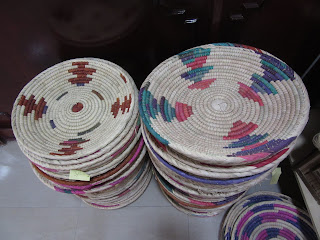















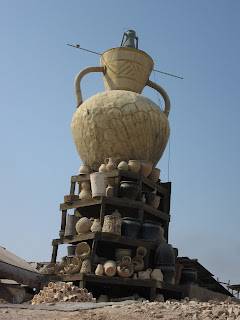



















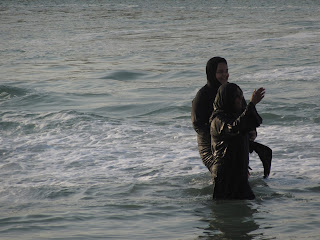
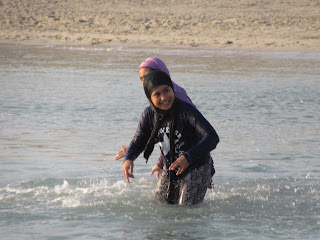




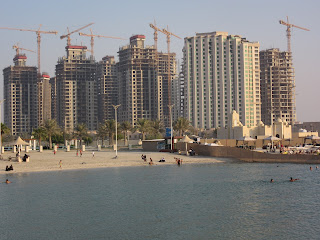














No comments:
Post a Comment
We love to hear from you!!!!